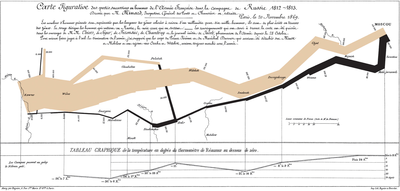Sankey diagram: Difference between revisions
m Reverted edits by 80.194.71.114 (talk) to last revision by Faizan (HG) |
|||
| Line 22: | Line 22: | ||
{{Expand section|date=January 2007}} |
{{Expand section|date=January 2007}} |
||
((GOOGLE)) |
|||
==External links== |
==External links== |
||
Revision as of 13:59, 18 June 2013


Sankey diagrams are a specific type of flow diagram, in which the width of the arrows is shown proportionally to the flow quantity. They are typically used to visualize energy or material or cost transfers between processes.
Application
They are also commonly used to visualize the energy accounts or material flow accounts on a regional or national level. Sankey diagrams put a visual emphasis on the major transfers or flows within a system. They are helpful in locating dominant contributions to an overall flow. Often, Sankey diagrams show conserved quantities within defined system boundaries, typically energy or mass, but they can also be used to show flows of non-conserved quantities such as exergy. Sankey Diagrams drop their arrows when energy is being used.
One of the most famous Sankey diagrams is Charles Minard's Map of Napoleon's Russian Campaign of 1812. It is a flow map, overlaying a Sankey diagram onto a geographical map. It was created in 1869.
Sankey diagrams are named after Irish Captain Matthew Henry Phineas Riall Sankey, who used this type of diagram in 1898 in a publication on the energy efficiency of a steam engine (see reproduction in,[1] page 8). While the first charts in black and white were merely used to display one type of flow (e.g. steam), using colors for different types of flows has added more degrees of freedom to Sankey diagrams.
Another example is the United States Energy Use developed by the US Department of Energy's Lawrence Livermore Laboratory.
See also
- Thermodynamics
- Material flow management
- Grassmann diagram[1] (exergy flow and loss)
References
- ^ Mario Schmidt (2006). "Der Einsatz von Sankey-Diagrammen im Stoffstrommanagement" (pdf). Beitraege der Hochschule Pforzheim (Nr. 124).
{{cite journal}}:|issue=has extra text (help)
This section needs expansion. You can help by adding to it. (January 2007) |
((GOOGLE))
External links
- Scottish Executive - Energy in Scotland: Supply and Demand
- Irish Environmental Protection Agency - Material Flow Accounts (MFAs) – Demonstration for Ireland - 2001
- sankey-diagrams.com – Blog discussing the usage of Sankey diagrams
- Energy in a Sustainability Problem archived presentation from MIT ‐ Professional Education Course, June 2012, which uses both Sankey and Grassmann diagrams to present information
